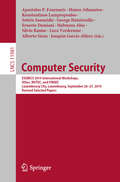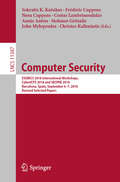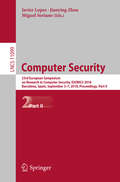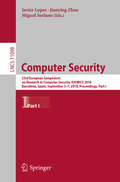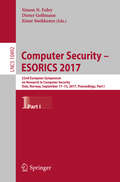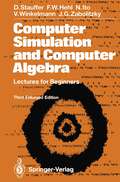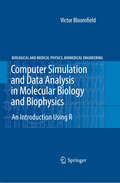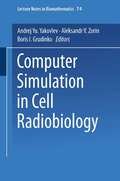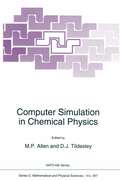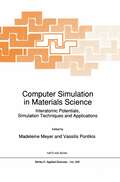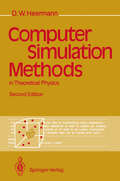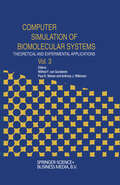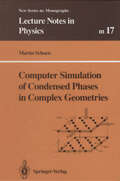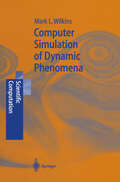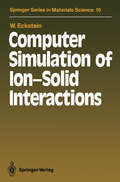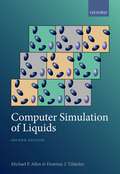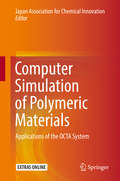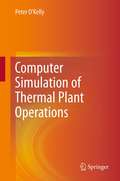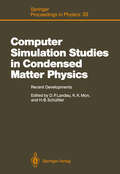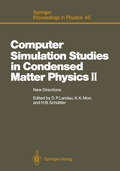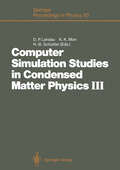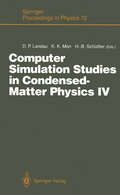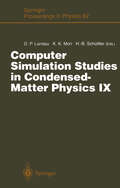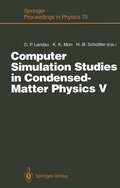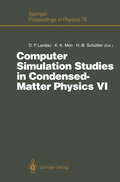- Table View
- List View
Computer Security: ESORICS 2019 International Workshops, IOSec, MSTEC, and FINSEC, Luxembourg City, Luxembourg, September 26–27, 2019, Revised Selected Papers (Lecture Notes in Computer Science #11981)
by Apostolos P. Fournaris Manos Athanatos Konstantinos Lampropoulos Sotiris Ioannidis George Hatzivasilis Ernesto Damiani Habtamu Abie Silvio Ranise Luca Verderame Alberto Siena Joaquin Garcia-AlfaroThis book constitutes the refereed post-conference proceedings of the Second International Workshop on Information & Operational Technology (IT & OT) security systems, IOSec 2019 , the First International Workshop on Model-driven Simulation and Training Environments, MSTEC 2019, and the First International Workshop on Security for Financial Critical Infrastructures and Services, FINSEC 2019, held in Luxembourg City, Luxembourg, in September 2019, in conjunction with the 24th European Symposium on Research in Computer Security, ESORICS 2019. The IOSec Workshop received 17 submissions from which 7 full papers were selected for presentation. They cover topics related to security architectures and frameworks for enterprises, SMEs, public administration or critical infrastructures, threat models for IT & OT systems and communication networks, cyber-threat detection, classification and pro ling, incident management, security training and awareness, risk assessment safety and security, hardware security, cryptographic engineering, secure software development, malicious code analysis as well as security testing platforms. From the MSTEC Workshop 7 full papers out of 15 submissions are included. The selected papers deal focus on the verification and validation (V&V) process, which provides the operational community with confidence in knowing that cyber models represent the real world, and discuss how defense training may benefit from cyber models. The FINSEC Workshop received 8 submissions from which 3 full papers and 1 short paper were accepted for publication. The papers reflect the objective to rethink cyber-security in the light of latest technology developments (e.g., FinTech, cloud computing, blockchain, BigData, AI, Internet-of-Things (IoT), mobile-first services, mobile payments).
Computer Security: ESORICS 2018 International Workshops, CyberICPS 2018 and SECPRE 2018, Barcelona, Spain, September 6–7, 2018, Revised Selected Papers (Lecture Notes in Computer Science #11387)
by Sokratis K. Katsikas Frédéric Cuppens Nora Cuppens Costas Lambrinoudakis Annie Antón Stefanos Gritzalis John Mylopoulos Christos KalloniatisThis book constitutes the thoroughly refereed post-conference proceedings of the 4th International Workshop on the Security of Industrial Control Systems and Cyber-Physical Systems, CyberICPS 2018, and the Second International Workshop on Security and Privacy Requirements Engineering, SECPRE 2018, held in Barcelona, Spain, in September 2018, in conjunction with the 23rd European Symposium on Research in Computer Security, ESORICS 2018. The CyberICPS Workshop received 15 submissions from which 8 full papers were selected for presentation. They cover topics related to threats, vulnerabilities and risks that cyber-physical systems and industrial control systems face; cyber attacks that may be launched against such systems; and ways of detecting and responding to such attacks. From the SECPRE Workshop 5 full papers out of 11 submissions are included. The selected papers deal with aspects of security and privacy requirements assurance and evaluation; and security requirements elicitation and modelling.
Computer Security: 23rd European Symposium on Research in Computer Security, ESORICS 2018, Barcelona, Spain, September 3-7, 2018, Proceedings, Part II (Lecture Notes in Computer Science #11099)
by Javier Lopez Jianying Zhou Miguel SorianoThe two-volume set, LNCS 11098 and LNCS 11099 constitutes the refereed proceedings of the 23nd European Symposium on Research in Computer Security, ESORICS 2018, held in Barcelona, Spain, in September 2018.The 56 revised full papers presented were carefully reviewed and selected from 283 submissions. The papers address issues such as software security, blockchain and machine learning, hardware security, attacks, malware and vulnerabilities, protocol security, privacy, CPS and IoT security, mobile security, database and web security, cloud security, applied crypto, multi-party computation, SDN security.
Computer Security: 23rd European Symposium on Research in Computer Security, ESORICS 2018, Barcelona, Spain, September 3-7, 2018, Proceedings, Part I (Lecture Notes in Computer Science #11098)
by Javier Lopez Jianying Zhou Miguel SorianoThe two-volume set, LNCS 11098 and LNCS 11099 constitutes the refereed proceedings of the 23nd European Symposium on Research in Computer Security, ESORICS 2018, held in Barcelona, Spain, in September 2018.The 56 revised full papers presented were carefully reviewed and selected from 283 submissions. The papers address issues such as software security, blockchain and machine learning, hardware security, attacks, malware and vulnerabilities, protocol security, privacy, CPS and IoT security, mobile security, database and web security, cloud security, applied crypto, multi-party computation, SDN security.
Computer Security – ESORICS 2017: 22nd European Symposium on Research in Computer Security, Oslo, Norway, September 11-15, 2017, Proceedings, Part I (Lecture Notes in Computer Science #10492)
by Simon N. Foley Dieter Gollmann Einar SnekkenesThe two-volume set, LNCS 10492 and LNCS 10493 constitutes the refereed proceedings of the 22nd European Symposium on Research in Computer Security, ESORICS 2017, held in Oslo, Norway, in September 2017.The 54 revised full papers presented were carefully reviewed and selected from 338 submissions. The papers address issues such as data protection; security protocols; systems; web and network security; privacy; threat modeling and detection; information flow; and security in emerging applications such as cryptocurrencies, the Internet of Things and automotive.
Computer Simulation and Computer Algebra: Lectures for Beginners
by Dietrich Stauffer Friedrich W Hehl Nobuyasu Ito Volker Winkelmann John G. ZabolitzkyComputer Simulation and Computer Algebra. Starting from simple examples in classical mechanics, these introductory lectures proceed to simulations in statistical physics (using FORTRAN) and then explain in detail the use of computer algebra (by means of Reduce). This third edition takes into account the most recent version of Reduce (3.4.1) and updates the description of large-scale simulations to subjects such as the 170000 X 170000 Ising model. Furthermore, an introduction to both vector and parallel computing is given.
Computer Simulation and Data Analysis in Molecular Biology and Biophysics: An Introduction Using R (Biological and Medical Physics, Biomedical Engineering)
by Victor BloomfieldThis book provides an introduction to two important aspects of modern bioch- istry, molecular biology, and biophysics: computer simulation and data analysis. My aim is to introduce the tools that will enable students to learn and use some f- damental methods to construct quantitative models of biological mechanisms, both deterministicandwithsomeelementsofrandomness;tolearnhowconceptsofpr- ability can help to understand important features of DNA sequences; and to apply a useful set of statistical methods to analysis of experimental data. The availability of very capable but inexpensive personal computers and software makes it possible to do such work at a much higher level, but in a much easier way, than ever before. TheExecutiveSummaryofthein?uential2003reportfromtheNationalAcademy of Sciences, “BIO 2010: Transforming Undergraduate Education for Future - search Biologists” [12], begins The interplay of the recombinant DNA, instrumentation, and digital revolutions has p- foundly transformed biological research. The con?uence of these three innovations has led to important discoveries, such as the mapping of the human genome. How biologists design, perform, and analyze experiments is changing swiftly. Biological concepts and models are becoming more quantitative, and biological research has become critically dependent on concepts and methods drawn from other scienti?c disciplines. The connections between the biological sciences and the physical sciences, mathematics, and computer science are rapidly becoming deeper and more extensive.
Computer Simulation in Cell Radiobiology (Lecture Notes in Biomathematics #74)
by Andrej Yu. Yakovlev Aleksandr V. ZorinComputer Simulation in Chemical Physics (Nato Science Series C: #397)
by M. P. Allen D. J. TildesleyComputer Simulation in Chemical Physics contains the proceedings of a NATO Advanced Study Institute held at CORISA, Alghero, Sardinia, in September 1992. In the five years that have elapsed since the field was last summarized there have been a number of remarkable advances which have significantly expanded the scope of the methods. Good examples are the Car--Parrinello method, which allows the study of materials with itinerant electrons; the Gibbs technique for the direct simulation of liquid--vapor phase equilibria; the transfer of scaling concepts from simulations of spin models to more complex systems; and the development of the configurational--biased Monte-Carlo methods for studying dense polymers. The field has also been stimulated by an enormous increase in available computing power and the provision of new software. All these exciting developments, an more, are discussed in an accessible way here, making the book indispensable reading for graduate students and research scientists in both academic and industrial settings.
Computer Simulation in Materials Science: Interatomic Potentials, Simulation Techniques and Applications (NATO Science Series E: #205)
by M. Meyer Vassilis PontikisThis volume collects the contributions! to the NATO Advanced Study Institute (ASI) held in Aussois (France) by March 25 - April 5, 1991. This NATO ASI was intended to present and illustrate recent advances in computer simulation techniques applied to the study of materials science problems. Introductory lectures have been devoted to classical simulations with special reference to recent technical improvements, in view of their application to complex systems (glasses, molecular systems . . . ). Several other lectures and seminars focused on the methods of elaboration of interatomic potentials and to a critical presentation of quantum simulation techniques. On the other hand, seminars and poster sessions offered the opportunity to discuss the results of a great variety of simulation studies dealing with materials and complex systems. We hope that these proceedings will be of some help for those interested in simulations of material properties. The scientific committee advises have been of crucial importance in determining the conference program. The directors of the ASI express their gratitude to the colleagues who have participated to the committee: Y. Adda, A. Bellemans, G. BIeris, J. Castaing, C. R. A. Catlow, G. Ciccotti, J. Friedel, M. Gillan, J. P. Hansen, M. L. Klein, G. Martin, S. Nose, L. Rull-Fernandez, J. Valleau, J. Villain. The main financial support has been provided by the NATO Scientific Affairs Division and the Commission of European Communities (plan Science).
Computer Simulation Methods in Theoretical Physics
by Dieter W. HeermannComputational methods pertaining to many branches of science, such as physics, physical chemistry and biology, are presented. The text is primarily intended for third-year undergraduate or first-year graduate students. However, active researchers wanting to learn about the new techniques of computational science should also benefit from reading the book. It treats all major methods, including the powerful molecular dynamics method, Brownian dynamics and the Monte-Carlo method. All methods are treated equally from a theroetical point of view. In each case the underlying theory is presented and then practical algorithms are displayed, giving the reader the opportunity to apply these methods directly. For this purpose exercises are included. The book also features complete program listings ready for application.
Computer Simulation of Biomolecular Systems: Theoretical and Experimental Applications (Computer Simulations of Biomolecular Systems #3)
by W. F. Van Gunsteren P. K. Weiner A. J. WilkinsonThe third volume in the series on Computer Simulation of Biomolecular Systems continues with the format introduced in the first volume [1] and elaborated in the second volume [2]. The primary emphasis is on the methodological aspects of simulations, although there are some chapters that present the results obtained for specific systems of biological interest. The focus of this volume has changed somewhat since there are several chapters devoted to structure-based ligand design, which had only a single chapter in the second volume. It seems useful to set the stage for this volume by quoting from my preface to Volume 2 [2]. "The long-range 'goal of molecular approaches to biology is to describe living systems in terms of chemistry and physics. Over the last fifty years great progress has been made in applying the equations representing the underlying physical laws to chemical problems involv ing the structures and reactions of small molecules. Corresponding studies of mesoscopic systems have been undertaken much more recently. Molecular dynamics simulations, which are the primary focus of this volume, represent the most important theoretical approach to macromolecules of biological interest." ...
Computer Simulation of Condensed Phases in Complex Geometries (Lecture Notes in Physics Monographs #17)
by Martin SchoenMolecularly small confined phases play an important role in many scientific and engineering disciplines. For instance, the confining membrane of a living cell is known to affect the structure and transport of cellular water, which mediates the cell's metabolism and other biochemical processes. Transport of hazardous waste through the soil is strongly influenced by the adsorption of bulk phase molecules on the confining mineral _surfaces. Finally, molecularly thin confined fluid films play a prominent part in lubrication. These examples illustrate the broad range of natural and commercial processes to which the present subject pertains. Much experimental effort has been devoted to molecularly small confined phases, revealing the intriguing nature of such systems. Several sections of this book are therefore devoted to descriptions of experimental techniques. To date even the most refined experiments do not yield direct information about structure and processes on the molecular scale. Computer simulations, on the other hand, do give such information and therefore complement real laboratory experiments. Several sections of this book discuss the link between experiments and the corre sponding simulations.
Computer Simulation of Dynamic Phenomena (Scientific Computation)
by Mark L. WilkinsA description of computer programs for simulating phenomena in hydrodynamics, gas dynamics, and elastic plastic flow in one, two, and three dimensions. The text covers Maxwell's equations, and thermal and radiation diffusion, while the numerical procedures described permit the exact conservation of physical properties in the solutions of the fundamental laws of mechanics. The author also treats materials, including the use of simulation programs to predict material behavior.
Computer Simulation of Ion-Solid Interactions (Springer Series in Materials Science #10)
by Wolfgang EcksteinIn this book the author discusses the investigation of ion bombardment of solids by computer simulation, with the aim of demonstrating the usefulness of this approach to the problem of interactions of ions with solids. The various chapters present the basic physics behind the simulation programs, their structure and many applications to different topics. The two main streams, the binary collision model and the classical dynamics model, are discussed, as are interaction potentials and electronic energy losses. The main topics investigated are backscattering, sputtering and implantation for incident atomic particles with energies from the eV to the MeV range. An extensive overview of the literature is given, making this book of interest to the active reseacher as well to students entering the field.
Computer Simulation of Liquids
by Michael P. Allen Dominic J. TildesleyThis book provides a practical guide to molecular dynamics and Monte Carlo simulation techniques used in the modelling of simple and complex liquids. Computer simulation is an essential tool in studying the chemistry and physics of condensed matter, complementing and reinforcing both experiment and theory. Simulations provide detailed information about structure and dynamics, essential to understand the many fluid systems that play a key role in our daily lives: polymers, gels, colloidal suspensions, liquid crystals, biological membranes, and glasses. The second edition of this pioneering book aims to explain how simulation programs work, how to use them, and how to interpret the results, with examples of the latest research in this rapidly evolving field. Accompanying programs in Fortran and Python provide practical, hands-on, illustrations of the ideas in the text.
Computer Simulation of Polymeric Materials: Applications of the OCTA System
by Japan Association for Chemical InnovationThis book is the first to introduce a mesoscale polymer simulation system called OCTA. With its name derived from "Open Computational Tool for Advanced material technology," OCTA is a unique software product, available without charge, that was developed in a project funded by Japanese government. OCTA contains a series of simulation programs focused on mesoscale simulation of the soft matter COGNAC, SUSHI, PASTA, NAPLES, MUFFIN, and KAPSEL. When mesoscale polymer simulation is performed, one may encounter many difficulties that this book will help to overcome. The book not only introduces the theoretical background and functions of each simulation engine, it also provides many examples of the practical applications of the OCTA system. Those examples include predicting mechanical properties of plastic and rubber, morphology formation of polymer blends and composites, the micelle structure of surfactants, and optical properties of polymer films. This volume is strongly recommended as a valuable resource for both academic and industrial researchers who work in polymer simulation.
Computer Simulation of Thermal Plant Operations
by Peter O'KellyThis book describes thermal plant simulation, that is, dynamic simulation of plants which produce, exchange and otherwise utilize heat as their working medium. Directed at chemical, mechanical and control engineers involved with operations, control and optimization and operator training, the book gives the mathematical formulation and use of simulation models of the equipment and systems typically found in these industries. The author has adopted a fundamental approach to the subject. The initial chapters provide an overview of simulation concepts and describe a suitable computer environment. Reviews of relevant numerical computation methods and fundamental thermodynamics are followed by a detailed examination of the basic conservation equations. The bulk of the book is concerned with development of specific simulation models. Care is taken to trace each model derivation path from the basic underlying physical equations, explaining simplifying and restrictive assumptions as they arise and relating the model coefficients to the physical dimensions and physical properties of the working materials. Numerous photographs of real equipment complement the text and most models are illustrated by numerical examples based on typical real plant operations.
Computer Simulation Studies in Condensed Matter Physics: Recent Developments Proceeding of the Workshop, Athens, GA, USA, February 15–26, 1988 (Springer Proceedings in Physics #33)
by David P. Landau Kin K. Mon Heinz-Bernd SchüttlerComputer simulation studies in condensed matter physics form a rapidly developing field making sigificant contributions to important physical problems. The papers in this volume present new physical results and report new simulation techniques and new ways of interpreting simulational data, which cover simulation of both classical and quantum systems. Topics treated include - Multigrid and nonlocal updating methods in Monte Carlo simulations - Simulations of magnetic excitations and phase transitions - Simulations of aggregate formation - Molecular dynamics and Monte Carlo studies of polymers, polymer mixtures, and fluid flow - Quantum path integral and molecular dynamics studies of clusters and adsorbed layers on surfaces - New methods for simulating interacting boson and fermion systems - Simulational studies of electronic structure.
Computer Simulation Studies in Condensed Matter Physics II: New Directions Proceedings of the Second Workshop, Athens, GA, USA, February 20–24, 1989 (Springer Proceedings in Physics #45)
by David P. Landau Kin K. Mon Heinz-Bernd SchüttlerA broad overview of recent developments in computer simulation studies of condensed matter systems is provided in this book. Both classical and quantum systems are discussed. The contributions present new physical results and describe new simulation techniques and novel ways of interpreting simulational data. Topics covered include: - parallelization and vectorization - cellular automata, fractals and aggregation - damage spreading - molecular dynamics of proteins and rotating molecules in solids - quantum Monte Carlo studies of strongly correlated electron systems
Computer Simulation Studies in Condensed Matter Physics III: Proceedings of the Third Workshop Athens, GA, USA, February 12–16, 1990 (Springer Proceedings in Physics #53)
by David P. Landau K. K. Mon Heinz-Bernd SchüttlerThe contribution of computer simulation studies to our understanding of the prop erties of a wide range of condensed matter systems is now weIl established. The Center for Simulational Physics of the University of Georgia has been hosting a series of annual workshops with the intent of bringing together experienced prac titioners in the field, as weIl as relative newcomers, to provide a forum for the exchange of ideas and recent results. This year's workshop, the third in the series, was held February 12-16, 1990. These proceedings are arecord of the workshop and are published with the goal of timely dissemination of the papers to a wider audience. The proceedings are divided into four parts. The first contains invited pa pers dealing with simulational studies of classical systems and also includes an introduction to some new simulation techniques. Aseparate section is devoted to invited papers on quantum systems, including new results for strongly correlated electron and quantum spin models believed to be important for the description of high-Tc superconductors. The third part consists of a single invited paper, which presents a comprehensive treatment of issues associated with high perfor mance computing, including differences in architectures and a discussion of access strategies. The contributed papers constitute the final part.
Computer Simulation Studies in Condensed-Matter Physics IV: Proceedings of the Fourth Workshop, Athens, GA, USA, February 18–22, 1991 (Springer Proceedings in Physics #72)
by David P. Landau K. K. Mon Heinz-Bernd SchüttlerThe contribution of computer simulation studies to our understanding of proper ties of a wide range of condensed-matter systems is now well established. The Center for Simulational Physics has been hosting annual workshops with the in tent of bringing together some of the experienced practitioners in the field, as well as relative newcomers in the field, to provide a forum for the exchange of ideas and recent results. This year's workshop, the fourth in the series, was held at the University of Georgia, February 18-22, 1991. These proceedings are a record of the workshop and are published with the goal of timely dissemination of the papers to a wider audience. The proceedings are divided into three parts. The first part contains invited papers which deal with simulational studies of classical systems and includes an introduction to some new simulation techniques and special purpose comput ers as well. A separate section of the proceedings is devoted to invited papers on quantum systems including new results for strongly correlated electron and quantum spin models believed to be important for the description of high-T c superconductors. The contributed presentations comprise the final chapter.
Computer Simulation Studies in Condensed-Matter Physics IX: Proceedings of the Ninth Workshop Athens, GA, USA, March 4–9, 1996 (Springer Proceedings in Physics #82)
by David P. Landau Kin-Keung Mon Heinz-Bernd SchüttlerComputer Simulation Studies in Condensed-Matter Physics IX covers recent developments in this field. This workshop was the ninth in this series and was held at the University of Georgia, March 4-9, 1996, and these proceedings form a record which is published with the goal of timely dissemination of the material to a wider audience. This volume is composed of three parts. The first section contains invited papers that deal with simulational studies of classical systems. The second section of the proceedings is devoted to invited papers on quantum systems, including new results for strongly correlated electron and quantum spin models. The final section comprises contributed presentations.
Computer Simulation Studies in Condensed-Matter Physics V: Proceedings of the Fifth Workshop Athens, GA, USA, February 17–21, 1992 (Springer Proceedings in Physics #75)
by David P. Landau K. K. Mon Heinz-Bernd SchüttlerAs the role of computer simulations began to increase in importance, we sensed a need for a "meeting place" for both experienced simulators and neophytes to discuss new techniques and results in an evironment which promotes extended discussion. As a consequence of these concerns, The Center for Simulational Physics established an annual workshop on Recent Developments in Computer Simulation Studies in Condensed-Matter Physics. This year's workshop was the fifth in this series and the interest which the scientific community has shown demonstrates quite clearly the useful purpose which the series has served. The workshop was held at the University of Georgia, February 17-21, 1992, and these proceedings form a record of the workshop which is published with the goal of timely dissemination of the papers to a wider audience. The proceedings are divided into four parts. The first part contains invited papers which deal with simulational studies of classical systems and includes an introduction to some new simulation techniques and special purpose computers as well. A separate section of the proceedings is devoted to invited papers on quantum systems including new results for strongly correlated electron and quan tum spin models. The third section is comprised of a single, invited description of a newly developed software shell designed for running parallel programs. The contributed presentations comprise the final chapter.
Computer Simulation Studies in Condensed-Matter Physics VI: Proceedings of the Sixth Workshop, Athens, GA, USA, February 22–26, 1993 (Springer Proceedings in Physics #76)
by David P. Landau K. K. Mon Heinz-Bernd SchüttlerComputer Simulation Studies in Condensed-Matter Physics VI provides a broad overview of recent developments in this field. Based on the last workshop, it presents invited and contributed papers which describe new physical results, simulational techniques and ways of interpreting simulational data. Both classical and quantum systems are discussed.
